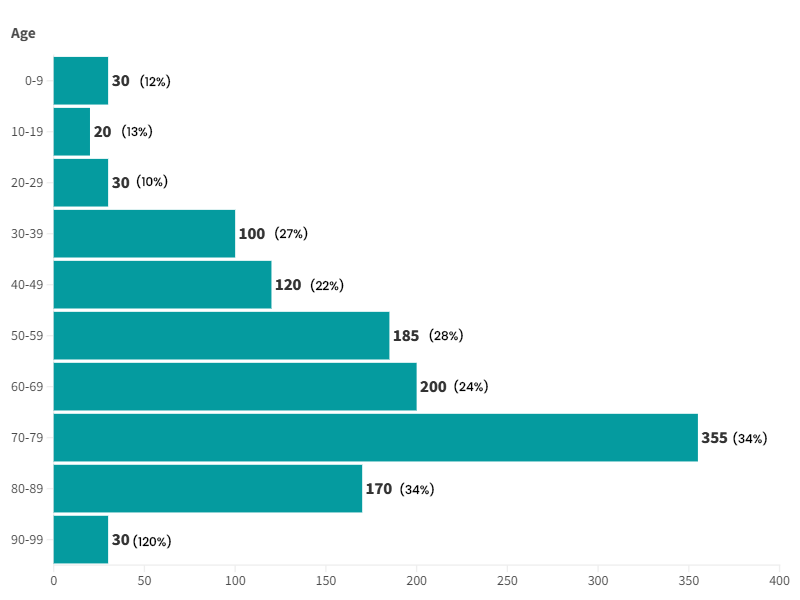In the latest of our quarterly updates, we use our unique, national dataset to look at the key trends in the independent healthcare sector up to, and including, Q2 2024. The data covers private healthcare in-patient/day-case market activity, insured cases, ‘self-pay’, along with national/regional and procedural breakdowns and demographic information. (Q1 = Jan – Mar; Q2 = Apr – Jun; Q3 = Jul – Sep; Q4 Oct – Dec)
Private healthcare sector market activity
In-patient/day-care admissions comparison Q1 2019 – Q2 2024

Q2 2024 in Northern Ireland at a glance
- There were over 5,900 reported private in-patient/day-care admissions.
- This is the second highest total ever and the highest for any April to June period.
- There was a small decline (3%) from Q1, but this was less pronounced than the equivalent period in 2023 (8%).
- The use of private medical insurance (PMI) was up 26% from the same quarter in 2023.
- Self-pay – where patients fund their own treatment from their savings, a loan or fundraising – also increased (5%) on same quarter in 2023.
Record independent healthcare in-patient admissions in Northern Ireland in Q2 2024
There were 5,945 reported admissions in Q2 2024, a 26% increase on the equivalent quarter in 2023 (4,700), and only a 3% decrease from the previous highest quarter (Q1 2024).
Q2 usually has lower admissions than Q1 at a UK level and Northern Ireland has also seen this pattern in 2023 and 2024. Overall there has been a steady rise in the number of reported admissions in Northern Ireland since Q3 2021.
There was a 374% increase in admissions between Q2 2019 and Q2 2024.
Some of the increases shown may be due to more complete data submission and improved clinical coding by the hospital groups in Northern Ireland to PHIN, meaning there is now a more accurate picture of activity.
Admission change by volume in Northern Ireland (Q2 2023 v Q2 2024)
%20by%20Nation%20(Q2%202023%20v%20Q2%202024).png)
Private medical insurance admissions continue to grow as self-pay remains steady
Insured admissions
When comparing Q2 2024 to Q2 2023, the number of admissions funded by private medical insurance were up by 48% in Northern Ireland. This was just -2% on Q1 2024 which is the record high.
Self-pay admissions
Self-pay admissions in Northern Ireland were up from the same quarter in 2023 (5%), but down (-4%) on the previous quarter (Q4 2023).
The proportion of people paying for treatment using insurance rose from 50% to 60% from Q2 2023 to Q2 2024.
Insured and Self-pay change by % (Q2 2023 v Q2 2024) (based on non-rounded figures)
%20(Q2%202023%20v%20Q2%202024).png)
Admissions (rounded) in Northern Ireland by payment method (Q2 2023 v Q2 2024)

Top 10 procedures (Q2 2023 v Q2 2024)
.png)
There was an increase in reported admissions in all but one of the top 10 procedures by volume when comparing Q1 2023 and Q1 2024, Gallbladder surgery remained the same.
‘Cataract surgery’ had the biggest increase at 323%. Only four of the Top 10 had increases of less than 100%. These large rises are likely to be a combination of an increase in admissions combined with more complete data submission to PHIN.
Active consultants in private healthcare

Although down on the previous two quarters, the number of consultants active in private healthcare remained high in Northern Ireland in Q2 2024, down just 3.6% on Q1 2024, meaning it was the third highest level since PHIN began collecting data. The number of active consultants in Q2 2024 was 1% higher than Q2 2023.
Quarterly comparison of active consultants for the top 10 PHIN specialties (Q2 2023 v Q2 2024)

There was an increase in active consultants in six of the Top 10. The largest increase was in ‘Opthalmology’ with an extra four consultants (21%). The largest fall was in ‘Cardiology’ where there were nine fewer active consultants (69%).
Patient demographics
Volume of admissions by sex and payment method (Q2 2023 v Q2 2024)
There was an increased number of insured admissions for both sexes and for female self-pay admissions compared to the same quarter in 2023. Male self-pay admissions were down from Q2 2023.
Insured admissions for females grew by 52% and males by 44%. The number of females using insurance is also higher.
Self-pay admissions increased by 11% for female patients and reduced by -6%) for male patients.
Purchaser type and sex (Q2 2023 v Q2 2024)

Change in volume of admissions by age
There was an increase in admissions in all age groups from Q2 2023 to Q2 2024 (except for those aged 100 or above for whom there were no admissions).
The largest increase in terms of volume was in the 70-79 age-group (355 extra admissions). The largest increase by percentage was the 90-99 age-group (120%).

Important notes
All data described above taken from PHIN’s unique, national private dataset describing discharge activity (day case and inpatient). This excludes activity outside of PHIN’s mandate from the Competition and Markets Authority, such as outpatient diagnostics and mental health.
There is a time lag between collecting, validating and processing the data we receive from hospitals before we can publish it. This can be up to 6 months after treatment has been completed, to ensure a fair process and accurate data.
Activity numbers have been rounded to the nearest 5, with percentage based on the unrounded figures.
